Queen Elizabeth’s death: The monarchy and the world will never be the same again
She was the stoic Queen who ruled over us for generations, a steadfast monarch who never wavered as wars, pandemics and prime ministers came and went before her.
Royals
Don't miss out on the headlines from Royals. Followed categories will be added to My News.
She was the stoic Queen who ruled over us for generations, a steadfast monarch who never wavered as wars, pandemics and prime ministers came and went before her.
Queen Elizabeth the Second, 96 years young, will forever be remembered for her service to the public, her duty to the Crown and the Commonwealth, and the deep affection with which she was held across the globe.

The world’s longest-serving monarch, she was the richest woman in the world, the most famous woman in the world, and for seven decades she headed a Commonwealth which encompassed 2.4 billion people.
She was known officially as Elizabeth II, by the Grace of God, of the United Kingdom of Great Britain and Northern Ireland and of Her other Realms and Territories Queen, Head of the Commonwealth, Defender of the Faith.

She was the Commander-in-Chief of the British Armed Forces and Head of the Church of England and its 85 million members.
She was Lilibet to her late husband Prince Philip; Mummy to the new King Charles; Granny to the heir Prince William; and Gan-Gan to the heir presumptive, her great-grandson Prince George.
She exercised soft power and advanced British interests by hosting elaborate state banquets for world leaders at Buckingham Palace in London, turning heads in her elegant ball-gowns and exquisite collection of priceless diamond tiaras and jewellery.

Yet she was most at home with her thoroughbred race horses, her dogs, and walking the moors in gumboots and a headscarf at her remote summer palace, Balmoral Castle in Scotland, where she spent as many summers as she could, visited by family, friends and the occasional British prime minister.
We admired her as she rode her ponies around Windsor Castle at the age of 94. We marvelled at her work ethic, as she continued to show up at community events and remembrance services, always impeccably dressed in bright coats, heels and hat.

We laughed along with her when she joined James Bond actor Daniel Craig and the palace corgis in a comic skydiving skit to open the London Olympics in 2012.
And our hearts broke for her as she sat, tiny and alone, in St George’s Chapel at the funeral for her beloved husband of 73 years Prince Philip, Covid restrictions preventing anyone from comforting her as the 99-year-old Duke of Edinburgh was laid to rest in April 2021.
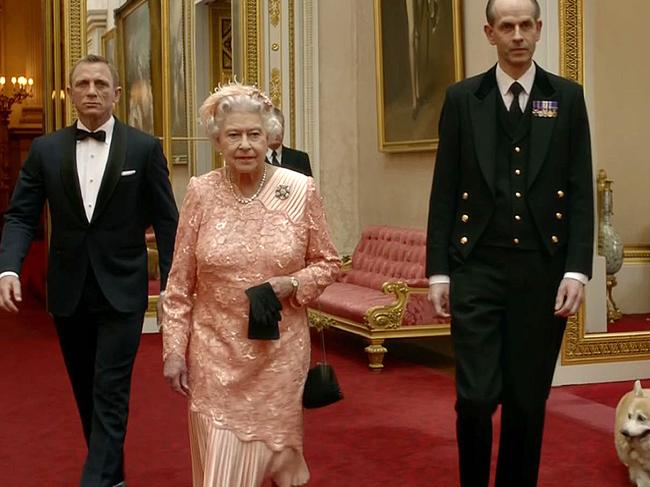
There were missteps along the path of her 70-year, 17-day reign. The misreading of the nation’s grief following the death of Diana, Princess of Wales in 1997. A failure to act quickly over her second son Prince Andrew’s scandalous friendship with the notorious paedophile Jeffrey Epstein.

Yet the Queen will be remembered as the woman who was always there, the young princess whose father became king by default, and who, on her 21st birthday, publicly declared “my whole life, whether it be long or short, shall be devoted to your service.’’
She was so stoic and in control of her emotions that the slogan Keep Calm and Carry On seemed custom-made for her – notwithstanding it was actually a British motivational wartime slogan from 1939, and bears the symbolic crown of her father King George VI.
EARLY LIFE
Princess Elizabeth Alexandra Mary arrived by caesarean section at 2.40am on April 21, 1926, at 17 Bruton Street in the exclusive suburb of Mayfair, in the home of her maternal grandparents the Earl and Countess of Strathmore. Named for her mother, the aristocratic Lady Elizabeth Marguerite Angela Bowes-Lyon, she was born into the house of Windsor, the name the royal family adopted in 1917 when it jettisoned its historic name of Saxe-Coburg-Gotha, which was proving problematic at the time of the Great War.

While she was technically third in line to the throne, her father Prince Albert, the Duke of York, was the second son and unlikely to become sovereign, and as a girl, she would be bumped down the line of succession by any future brothers and any children born to her uncle.
The affable Duke, known as Bertie, was entranced by his baby girl, and wrote a note shortly after her birth, stating “we have long wanted a child to make our happiness complete.’’
With no expectation that she would one day ascend the throne, little Elizabeth was allowed more freedoms than a future monarch would ordinarily expect, and enjoyed a carefree early life.

When she was just eight months old, her parents embarked on a six-month tour of Australia and New Zealand, leaving Princess Elizabeth in the care of her nanny, her mother’s parents, and her father’s parents, King George V and Queen Mary.
After they returned, they moved with their now-14-month-old daughter to 145 Piccadilly, a grand residence near Hyde Park, which is now the site of London’s Intercontinental Hotel. The home had a shared backyard where Elizabeth played with other children from the well-heeled neighbourhood, and a night and day nursery filled with toys and books.

Princess Elizabeth’s younger sister, Princess Margaret, was born in 1930, and, conscious of the difficulties faced by British citizens in the mean years between the wars, the Duke and Duchess of York avoided ostentatious displays of privilege for their daughters. They took their girls to visit other royal residences at Sandringham and Windsor, where they ran wild in the grounds and played with horses and dogs.
GROWING UP
Elizabeth went on to become an accomplished horsewoman – she barely flinched as a man fired six blank shots at her as she rode horseback during the Trooping the Colour parade in London in 1981 – and continued to ride ponies around the Windsor Great Park well into her 90s.
She also became an accomplished breeder and owner of racehorses, with her best runner, Auerole, finishing second in the Epsom Derby in the week of her coronation in 1953.
In keeping with royal tradition, the young princesses Elizabeth and Margaret were homeschooled by governesses, and studied history, geography, English, French and music.
The most influential of these governesses was Marian Crawford, known as “Crawfie’’, who arrived when Elizabeth was seven.

With no expectations on what she was to achieve upon adulthood apart from making a good marriage, Elizabeth’s early education schedule was not difficult, with study scheduled from 9.30am to 11am, and the afternoon set aside for games and dancing.
Her mother instilled in her a strong Christian faith, while grandmother Queen Mary taught both girls the finer art of royal protocols and etiquette, including, presumably, the restrained and distinctive “royal wave’’ she later perfected.
The sisters were the closest of friends, and the personalities they displayed in their adult years were apparent even as very young children – Princess Elizabeth was earnest and dutiful, and Princess Margaret stubborn and rebellious.
Elizabeth also proved to be good at her studies – which was fortuitous, given the momentous change looming in her young life.
QUEEN IN WAITING
In January 1936, Elizabeth’s grandfather, King George V, passed away, and his oldest son, Elizabeth’s Uncle David, became King, taking the regnal name King Edward VIII. But trouble was brewing in the House of Windsor, in the form of the King’s scandalous affair with the American divorcee Wallis Simpson.

Edward’s failure to marry and produce an heir had already caused consternation at the highest levels of government, but his entanglement with Ms Simpson, who would soon divorce her second husband, proved too much for the royal court to bear, and Edward was ordered to end his romance. He chose love over duty, and on December 10, 1936, abdicated the throne.

Unaware of the crisis enveloping her family, 10-year-old Elizabeth was writing up her notes from that day’s swimming lessons when she heard a crowd gathering outside 145 Piccadilly, chanting “God Save the King.’’ Seeking information from a footman, she was told her uncle had abdicated and her father was now the king.
According to reports, she ran to tell Margaret, who asked her: “Does that mean you will have to be the next queen?” When Elizabeth replied: “Yes, some day,” Margaret responded “Poor you.’’ Elizabeth’s swimming notes that day, according to BBC History, were headed “Abdication Day.”

The family moved down the road into Buckingham Palace, where Elizabeth’s father, now King George VI, threw himself into the role of sovereign. As heiress to the throne, Elizabeth found her carefree life was over. Queen Mary intervened to improve her granddaughter’s education. As the future head of the Church of England, she was given religious lessons from the Archbishop of Canterbury, and the vice-provost of Eton College was called upon to give her lessons in constitutional history. She also studied law.
MEETING PHILIP
Despite the drums of war beating across Europe, the royal family continued its public engagements, and in 1939, Elizabeth, now aged 13, and Margaret accompanied the King and Queen on a visit to the Britannia Royal Naval College in Dartmouth.
An 18-year-old cadet, Prince Philip of Greece and Denmark, was assigned to amuse the two girls during the visit. They were third cousins, related through Queen Victoria, and while they had apparently met years earlier at a family wedding, this was their first public meeting.
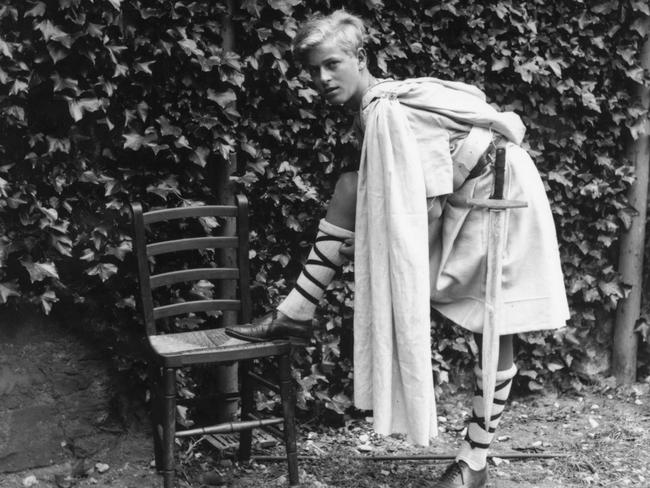
The trio played with a train set, were photographed having a game of croquet on a lawn, then, at Philip’s instigation, commenced jumping over the net on a tennis court.
Royal historian Christopher Warwick told Vanity Fair Princess Elizabeth was “just overwhelmed’’ by the tall, athletic, blond Philip, and her governess Miss Crawford noted in her diary that Elizabeth had said to her “see how he jumps.’’
In coming years, the pair would write to each other, and occasionally see each other at family gatherings at Windsor Castle, and their childhood friendship grew slowly into a serious romance.
DRUMS OF WAR
But the war would intervene, and with Britain formally entering the conflict on September 3 that year, King George and Queen Elizabeth withstood pressure to send the princesses to Canada. In the spring of 1940, they were sent to live at Windsor Castle for the duration of the war.
Elizabeth’s beloved childhood home, 145 Piccadilly, was destroyed in a German bombing raid, and more bombs rained down on Buckingham Palace, but the Princess stayed safe at the ancient castle at Windsor, disappearing into the underground vaults for safety when bombs fell on the Windsor Great Park.
In 1940, the then-14-year-old Elizabeth delivered her first public speech – a radio broadcast on the BBC to British child evacuees in North America, expressing sympathy and urging them to be courageous.

“Thousands of you in this country have had to leave your homes and be separated from your fathers and mothers. My sister Margaret Rose and I feel so much for you as we know from experience what it means to be away from those we love most of all,’’ the future Queen said in her broadcast.
“We know, every one of us, that in the end all will be well; for God will care for us and give us victory and peace. And when peace comes, remember it will be for us, the children of today, to make the world of tomorrow a better and happier place.’’

As the war dragged on, Prince Philip came to Windsor to spend Christmas with the family at the end of 1943, and was further charmed by the sensible and dedicated Princess Elizabeth, who was now 17. He returned to war determined to marry her; but a suggestion of marriage made by his cousin to King George VI backfired – the king thought Elizabeth far too young for marriage and Philip was advised he “had better not think any more about it at present”. There was also another problem – some considered Philip “too German.’’ While he was Prince of Greece and Denmark, his mother was a Hessian princess from the House of Schleswig-Holstein-Sonderburg-Glucksberg. His four sisters had married German princes, and three of those princes were members of the Nazi party. Elizabeth’s mother the Queen privately called him “the Hun”.
JOINING THE MILITARY
Four months later, as Elizabeth turned 18, she began taking on royal duties, and wanting to contribute to the war effort, convinced her father to allow her to join the Auxiliary Territorial Service as a trainee ambulance driver and mechanic.
She spent the remainder of the war in a military uniform and was praised for her driving skills, rising to the ranks of junior commander. She retained her love of driving all her life and still drove on the royal estates well into her 90s.


In 2003, she drove King Abdullah of Saudi Arabia around the estate at Balmoral in her Land Rover, at a time when women were banned from driving in the King’s home country.
When VE Day finally came on May 8, 1945, Elizabeth and Margaret joined their parents and the Prime Minister Winston Churchill on the balcony of Buckingham Palace to wave to the crowds, before Margaret suggested they slip out to join the festivities.

“All of us were swept along by tides of happiness and relief,’’ Elizabeth later wrote, recalling how she, Margaret and Miss Crawford had mingled with the crowd, chanting “we want the king,’’ before returning discreetly to the palace.
GETTING ENGAGED
When the war with Japan ended in 1946, Prince Philip returned to the UK, and began his official courtship of Elizabeth, taking her and Princess Margaret out to dinners and the theatre. Theirs was a genuine romance, as shown in a letter he wrote to the princess, quoted by author Philip Eade.
“To have been spared in the war and seen victory, to have been given the chance to rest and to readjust myself, to have fallen in love completely and unreservedly, makes all one’s personal and even the world’s troubles seem small and petty,” the young prince wrote to his princess.

Sometime that year during a visit to Balmoral castle in Scotland, he proposed marriage to Princess Elizabeth, presenting her with a three-carat diamond ring surrounded by smaller diamonds, crafted from jewels taken from a tiara that had belonged to his mother, Princess Alice of Battenberg.

King George agreed to the marriage – but insisted they must not announce their engagement until after the Princess had marked her 21st birthday.
In 1947, Elizabeth celebrated her milestone birthday while in South Africa on her first official overseas tour, famously declaring in a radio address that “I declare before you that my whole life, whether it shall be long or short, shall be devoted to your service.”
TYING THE KNOT
Shortly afterwards, on July 8, the engagement of Princess Elizabeth and Prince Philip was announced, to much excitement in the UK and across the empire. They would marry four months later, on November 20, 1947, in front of 2500 guests at Westminster Abbey, in a service broadcast live on radio across the globe. Given the country was still under rationing, the wedding was marketed as an “austerity wedding,’’ although the Government gave the young princess an extra 200 clothing coupons for her dress.

Before their wedding, Philip renounced his Greek and Danish titles, converted to the Church of England, and gave up smoking cigarettes. He took British citizenship and adopted the name of his British relatives, the Mountbattens. He was preparing for a role that would see him walk two steps behind his wife in public; a marriage where his wife and future children would not take his name, and within which he would forever be known not as a king, but as the Queen’s consort.

Half a million people lined the streets to watch the procession to Westminster Abbey; throwing confetti and waving Union Jack flags. When Elizabeth emerged, she was radiant in an ivory silk gown bedecked with 10,000 seed pearls and featuring a 4m long train; a dress that took 350 women seven weeks to sew. She wore the glittering Russian Fringe tiara owned by Queen Mary, while Prince Philip wore his navy uniform.
Their marriage was a true love match, and shortly after their wedding, Elizabeth wrote to her parents telling them “We behave as though we had belonged to each other for years.”
STARTING A FAMILY
They enjoyed several happy years together while Philip continued his navy career, living for several joy-filled months on the island of Malta. Their first child, heir to the throne Prince Charles, was born a year after their wedding, in November 1948. He was followed by a sister, Princess Anne, who arrived in 1950.
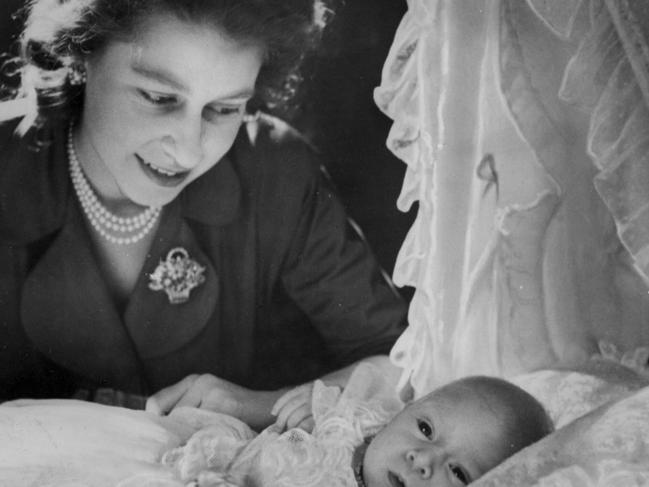
The couple took part in royal duties, and as the health of King George deteriorated, found themselves called upon more often. In 1951, they returned to London, ending Philip’s naval career to allow Elizabeth to be closer to the royal court as she stepped up her official duties on behalf of her seriously-ill father.
BECOMING QUEEN
On February 6, 1952, Elizabeth and Philip were in Kenya, at the start of a royal tour to Australia and New Zealand, when King George, a heavy smoker, succumbed to lung disease, and died at the Sandringham estate at the age of 56. Philip broke the news to his wife.
She cancelled her tour and headed straight back to London. She had left England a princess and returned days later, as Queen. She was 25 years old.

The Coronation of the new Sovereign was so elaborate, it took more than a year to organise and took place on June 2, 1953, at Westminster Abbey, the scene of her wedding to Prince Philip just a few years earlier. It followed traditions stretching back almost 1000 years – but broke new ground by becoming the first Coronation to be televised worldwide to millions of people. In the UK alone, 27 million people tuned in to watch their young Queen crowned.
Queen Elizabeth and Prince Philip made the journey to Westminster Abbey in the Gold State Coach – pulled by eight grey horses; the Queen stunning in a white satin Coronation dress embroidered with the emblems of the United Kingdom and the Commonwealth and carrying a white bouquet. On her head sat the George IV State Diadem crown, the one which appears on British postal stamps, featuring 1333 diamonds. She wore the Coronation dress a further six times, including in Australia in 1954.
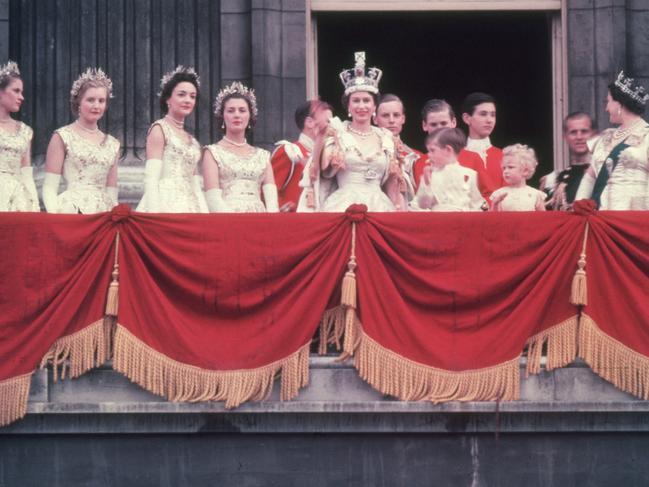
The spectacular Coronation ran for three hours, conducted by the Archbishop of Canterbury, with Elizabeth taking the oath, being anointed with oil, and being formally crowned. She was asked by the Archbishop if she would swear to govern: “Peoples of the United Kingdom of Great Britain and Northern Ireland, Canada, Australia, New Zealand, the Union of South Africa, Pakistan, and Ceylon, and of your Possessions and the other Territories to any of them belonging or pertaining, according to their respective laws and customs?’’
“I solemnly promise so to do,’’ Queen Elizabeth replied.

During the service, she donned the Saint Edward’s Crown, a solid gold crown made in 1661, and reserved for the most special of occasions. The orb, also made of solid gold and surrounded by a cross encircled with a band of diamonds, emeralds, rubies, sapphire and pearls with a large amethyst at the summit, was placed in her hand as she was crowned.
The route back to the palace was designed to allow as many people as possible to see the royal couple, and took two hours to complete. An extraordinary 30,000 men took part, from the Navy, Army and Air Force, along with 2000 drawn from the Commonwealth and another 500 from what was then known as the “colonies.’’
Prince Charles and Princess Anne joined their parents on the balcony at Buckingham Palace to wave to the crowds, and footage was later released of the young royals playing peekaboo – part of the Queen’s determination to raise her children in a more modern fashion.
To this end, she determined they should go to public schools, and would not be home-tutored like generations before them.
NEW RULE
The new Queen quickly established a reputation for taking a deep interest in government affairs.
Her first prime minister was the wartime leader Winston Churchill and she formed a close bond with him.

Every week she had an audience with the prime minister of the day, until the Covid pandemic of 2020 required the meetings to be held by telephone.
Every day, she read the government documents sent to her in red dispatch boxes, rubber-stamped thousands of pieces of legislation through a process known as Royal Assent, and worked closely with the Office of the Prime Minister and Foreign and Commonwealth Office to enhance British interests domestically and abroad.
She also threw herself into nurturing the countries of the Commonwealth – which currently number 54 – including the 16 countries of the Realm of which Elizabeth was head of state.
AUSTRALIAN TOUR
Two years after their aborted trip to Australia, the now-Queen and Prince Philip finally made it Down Under, arriving on February 3, 1954.
So popular was the young monarch an estimated one million people turned out to see her in Sydney when the couple disembarked the Royal Yacht Britannia in Sydney Harbour.
The couple toured the country for eight weeks, visiting 57 towns and cities from Cairns to Broome to Hobart.
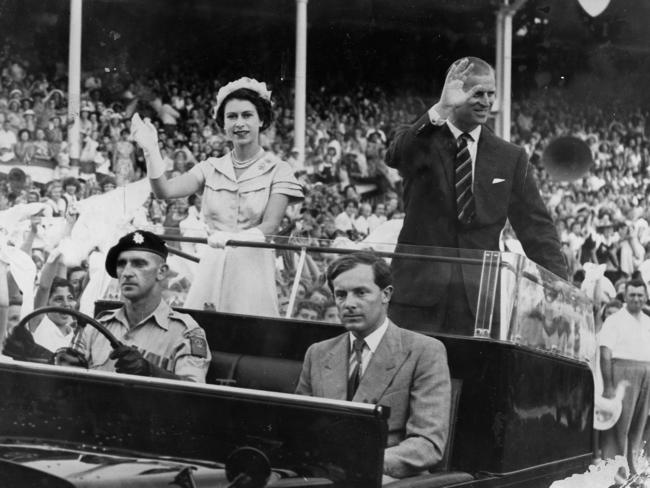
It was the first of 16 visits the Queen would make over the years, and was considered a huge success, with hundreds of thousands of people turning out to see the monarch, who was always dressed in prim frocks, hat and gloves, often waving from an open-topped car.
In 1960, Queen Elizabeth gave birth to another son, Prince Andrew, followed in 1964 by her youngest son, Prince Edward.

A year later, she made global headlines when she danced with Ghanaian president Kwame Nkrumah. Amid fears Ghana would leave the Commonwealth, the Queen made a diplomatic dash to Accra, and the sight of the smiling Queen dancing in the arms of a black president ricocheted around the globe, at a time when segregation still existed in the United States.


It was on a visit to Australia in 1970 with Prince Philip and Princess Anne that the Queen set a precedent which continues to this day; the royal walkabout.
Instead of waving at the crowds from a car, Elizabeth took the advice of her then-private secretary, Australian Sir William Heseltine, and walked along the street in Sydney, shaking hands with members of the crowd and accepting small floral bouquets.
25-YEAR REIGN
In 1977, the Queen and Prince Philip set out from Buckingham Palace in the Gold State Coach to mark her 25 years on the throne.
Arriving at St Paul’s Cathedral, she repeated her vow of lifetime service, made on her 21st birthday, and added: “Although that vow was made in my salad days when I was green in judgment, I do not regret nor retract one word of it.”
By the 1980s, the House of Windsor was gripped by wedding fever; Prince Charles and Lady Diana Spencer wed in 1981 in a spectacular ceremony witnessed by global television audiences; while Prince Andrew tied the knot with a bubbly commoner, Sarah Ferguson in 1986.
The no-fuss Princess Anne and Mark Phillips had married with somewhat less fanfare in 1973, while Prince Edward was to marry Sophie Rhys-Jones in 1999.



The weddings of the two older Windsor boys marked a high point in the royal family’s standing; Sarah, the Duchess of York was considered a breath of fresh air, and Princess Diana’s approval ratings were stratospheric.
Charles and Diana’s son, heir-to-the-throne Prince William, was born in 1982, followed by Prince Harry in 1984, and Diana’s hands-on approach to raising her sons won huge praise from the public.
ANNUS HORRIBILIS
But a decade on, royal relationships were foundering, and the House of Windsor helmed by Queen Elizabeth was in crisis.
Charles and Diana were at war, and Charles was continuing his relationship with his mistress Camilla Parker Bowles.

In 1989, a mortifying phone call between Charles and Camilla was made public, where Charles mused about being reincarnated as Camilla’s tampon.
In her annual Christmas message the Queen labelled 1992 her “annus horribilis’’ – a horrible year – that saw the inevitable, formal collapse of Charles and Diana’s marriage, Princess Anne divorce and Sarah Ferguson, recently separated from Prince Andrew, photographed having her toes sucked by her lover.
A fire that year almost burned down Windsor Castle, and resulted in the royal family opening Windsor and Buckingham Palace to tourists to raise money to pay for the repairs.
DEATH OF DIANA
It seemed impossible, but there was worse to come. In 1997, Diana, Princess of Wales, died in a car accident after fleeing the paparazzi with her new boyfriend, millionaire playboy Dodi Fayed, in Paris.
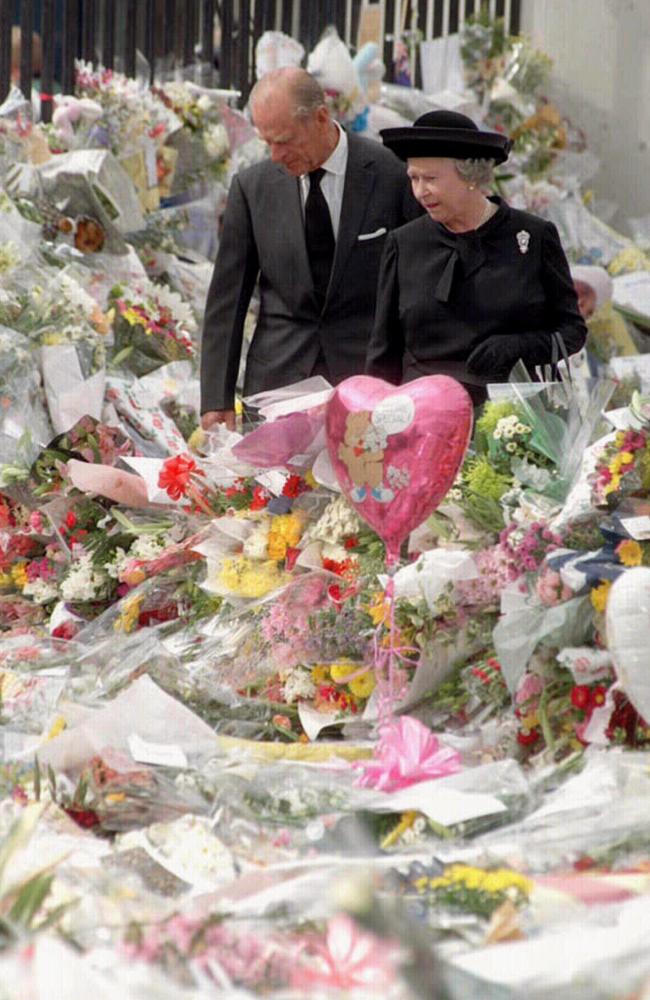
The palace grossly underestimated the extent of the nation’s grief, and the Queen only emerged to pay public tribute to Diana after then-prime minister Tony Blair labelled her the “people’s princess.’’
The Queen made a live broadcast from Buckingham Palace “as your Queen and as a grandmother’’, paying tribute to Diana as an “exceptional and gifted human being”.
“I admired and respected her — for her energy and commitment to others, and especially for her devotion to her two boys.’’
LOVE OF HER LIFE
It was a damaging low point for the royal family, and some wondered if The Firm would ever recover. But the Queen kept calm and carried on, and a few months later, shared a few details on the greatest, most stable relationship of her life – her marriage to Prince Philip.
“He has, quite simply, been my strength and stay all these years,” she said in November that year at an event to mark their golden wedding anniversary.
“I, and his whole family, and this and many other countries, owe him a debt greater than he would ever claim, or we shall ever know.”

Those understated sentiments reflected the Queen’s great love and affection for the man who had followed her for decades, given up his naval career to support her and was by her side for every major event in their lives. He ran the royal estates on behalf of the Queen at Windsor, Sandringham and Balmoral and supported the family through personal crises such as marriage breakdowns.
Royal etiquette might have decreed that displays of affection were to be kept private, but the couple were photographed over the years holding hands, giggling discreetly together, and Philip occasionally planted a chaste kiss on the Queen’s cheek.


Out of the public eye, they were apparently down-to-earth and loving, with the Prince one of the few people on earth able to directly challenge or debate the Queen’s decisions or opinions.
In 2012, the Queen once again acknowledged her husband’s role in her public and private life, saying: “Prince Philip is, I believe, well known for declining compliments of any kind. But throughout he has been a constant strength and guide.”
ANNUS HORRIBILIS II
The monarch had turned to her husband for support in 2002, when her beloved sister Princess Margaret died in a London hospital.

The Queen had remained close with Princess Margaret throughout her reign, but a lack of a formal role for Margaret caused tension between the sisters, as did Margaret’s romance with the divorced Group Captain Peter Townsend, her affair with the much-younger Roddy Llewellyn, captured by the tabloids on the island of Mustique, and her tempestuous marriage to photographer Antony Armstrong-Jones, from whom she separated after 10 years of marriage.

A heavy smoker and drinker, Princess Margaret fell into ill health in her later years and was treated for mental illness and lung disease. She suffered serve burns to her feet and lower legs in a bathroom accident and became so immobile she was occasionally confined to a wheelchair.v
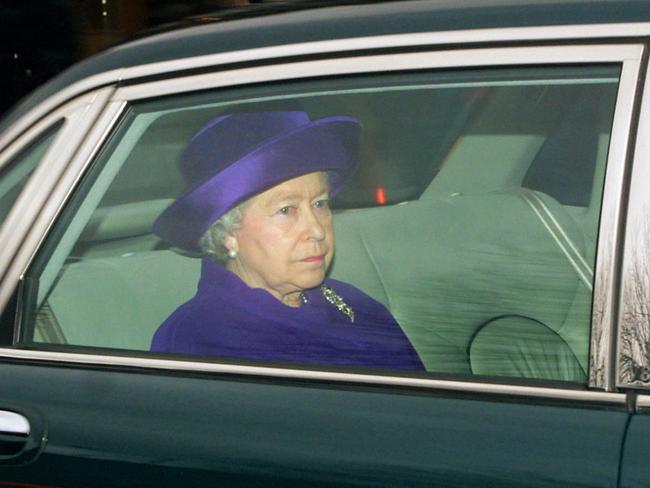
After suffering a series of strokes, she died at the age of 71, a devastating loss for her sister Elizabeth, who was seen wiping tears as she emerged from her funeral. Weeks later, Queen Elizabeth, the Queen Mother, died in her sleep at the grand age of 101.
50-YEAR REIGN
The stoic Queen did not have much time to recover from the heavy loss of the two most important women in her life. By June that year, the Commonwealth was celebrating her 50-year reign, with the Golden Jubilee celebration culminating in a parade on London’s The Mall which was attended by more than one million people, waving Union Jack flags and cheering the Queen’s good health.

She was feted across the Commonwealth, including in Australia, where she visited Queensland and South Australia and opened the Commonwealth Heads of Government Meeting (CHOGM) at Coolum.
Stamps and coins were issued to mark the occasion, and an official portrait unveiled by Buckingham Palace which showed the Queen resplendent in a white silk, satin and lace, wearing the State Diadem crown and dripping in diamonds. The dress was designed by Angela Kelly, the woman poached by Buckingham Palace in 1992 from the British Ambassador to Germany, who became the Queen’s official dresser.
FASHIONABLE MONARCH
Ms Kelly was responsible for the Queen’s rainbow-hued dresses and coats, topped with matching hats, gloves, leather top-handled bags from the design house Launer London and sensible heels from British shoemaker Anello & Davide.

Royal correspondents frequently say that she deliberately chose bright colours so that people standing deep in a crowd would be able to see her. Her biographer, Robert Hardman, reported the Queen once said: “I can never wear beige because nobody will know who I am.”
Another of the monarch’s biographers, Sally Bedell Smith, reported the Queen had declared “I have to be seen to be believed.’’
WORLD LEADERS
The Queen never believed however that she needed to be heard, in keeping with her lifelong determination to be apolitical and never engage in domestic or international politics.
She had hosted most of the world’s most powerful leaders at state banquets at Buckingham Palace, or at other royal residences, including Russian president Vladimir Putin in 2003, former US president Barack Obama and his wife Michelle in 2011, and another former president, Donald Trump and his wife Melania, in 2019.


She met Japan’s Emperor Hirohito in 1971, at a time when anti-Japanese sentiment was still strong in the UK, and hosted Chinese president Xi Jinping in 2015. In June 2021, she joined world leaders gathering at Cornwall on the English coast for the G7, meeting then German Chancellor Angela Merkel, Japan’s then-Prime Minister Yoshihide Suga, French President Emmanuel Macron, Canada’s Prime Minister Justin Trudeau, Britain’s then-Prime Minister Boris Johnson, Italy’s Prime Minister Mario Draghi and US President Joe Biden.


Mr Johnson was the 14th British prime minister of her reign, and she continued weekly audiences with him, as she had all her previous prime ministers, until the Covid-19 pandemic forced her to conduct the meetings via telephone, after she went into isolation at Windsor Castle.
WINDING BACK
The Queen’s last visit to Australia was in 2011, when the then-85-year-old monarch and her 90-year-old husband attended CHOGM in Perth. The meeting was notable for its decision to change royal succession rules, meaning firstborn girls would no longer be pushed down the line of succession by any brothers born after them.

In 2015 the Queen made her final overseas trip, again to attend CHOGM. This meeting was held on the island of Malta, where Elizabeth and Philip had spent the happy early months of their marriage together as the Duke continued to serve in the Royal Navy.
Prince Charles began to take on more of his mother’s duties as she reached her 90s, and reduced her working week to about three days. She still attended dozens of public event and made minor changes to her schedule to allow for her advancing years, such as no longer placing a wreath at the cenotaph on Remembrance Sunday, so she didn’t have to stand for the 20-minute service.

On October 13, 2021, she appeared at a church service at Westminster Abbey using a walking stick, the first time she’d been seen with a mobility support since 2004, after she underwent minor knee surgery. On October 22, it emerged she’d spent a night in hospital for tests, after cancelling a trip to Northern Ireland on doctor’s orders to allow her to have more rest. Hours after being released from hospital, she went back to reading her red box correspondence from the government.
Earlier that month, she opened the Scottish parliament, the first time in decades she had done so without Prince Philip by her side. “I have spoken before of my deep and abiding affection for this wonderful country, and of the many happy memories Prince Philip and I always held of our time here,’’ she said.
Dressed in a moss green dress coat and hat, a diamond brooch in the shape of a Scottish thistle of her lapel, the Queen looked much younger than her 95 years, as she delivered a speech and shook hands with officials, doing her duty, as she had done, without fuss, for the past seven decades.
The same went until she contracted Covid-19 on February 20, speaking with then-British Prime Minister Boris Johnson, by phone, just four days later.
Queen’s life in pictures: Running ‘The Firm’
THE FINAL CHAPTER
In many ways, the Queen’s final years were some of her hardest. While there were the births of great-grandchildren to celebrate, including heir to the throne Prince George in 2013 (followed by Charlotte in 2015, Louis in 2018, Archie in 2019 and namesake Lilibet in 2021), there was also great heartache.
The death of Prince Philip in April 2021 was tragic enough, but the restrictions of the Covid era lent his funeral an especially gloomy air, with the Queen sitting sad and alone throughout the service.
After the wedding of Prince Harry to American actress Meghan Markle in 2018, the Queen was also buffeted by their subsequent decision to turn their backs on the monarchy and relocate to the US.
The scandal surrounding Andrew and his ties to the sex trafficker Jeffrey Epstein also took its toll. Eventually the Queen would strip Andrew - long rumoured to be her favourite - of most of his royal titles and privileges.

Whilst generally enjoying good health throughout her life, in the last few years the usual complications of advanced age became apparent.
Princes Charles and Williams took on more of her duties as she reached her nineties, as she reduced her working week to about three days.
In October 2021 she appeared at a church service at Westminster Abbey using a walking stick, the first time she’d been seen with a mobility support since 2004, after she underwent minor knee surgery.
A week later it emerged she’d spent a night in hospital for tests, after cancelling a trip to Northern Ireland on doctor’s orders.

In February 2022 the Queen contracted Covid-19, an illness she later said left her “exhausted”.
There were concerns failing health would prevent her from participating in Platinum Jubilee celebrations in June, but she appeared a number of times, including on the balcony at Buckingham Palace.
There would be a couple of other minor public appearances in the weeks to follow, but the balcony appearance at the Jubilee would be the last time the British public at large would gather together, and to sing God Save the Queen in the presence of the woman who had been, in many ways, their own ‘strength and stay’ throughout the previous seven decades.



